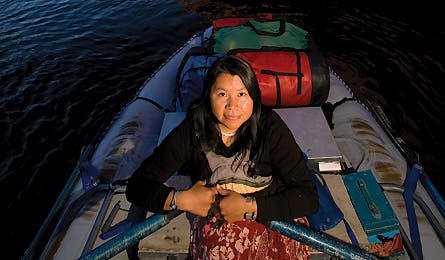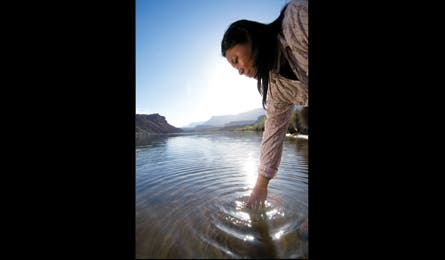River Keeper

'Watahomigie regularly leads float trips for VIPs who visit. (Dawn Kish)'

Watahomigie regularly leads float trips for VIPs who visit. (Dawn Kish)

(Photo by Dawn Kish)
Shana Watahomigie might as well have Colorado River water flowing through her veins. A Havasupai Indian, she hails from a people who believe their ancestors chose lush, life-giving Havasu Falls, in the heart of the Grand Canyon, as their homeland–while flying on the back of a giant condor. Thirty generations later, Watahomigie, 35, is the first and only Native American employed as a river permit ranger by the National Park Service. In September 2006, Watahomigie joined Robert F. Kennedy, Jr.; explorer and author Wade Davis; and 41 other boaters and filmmakers on an 18-day IMAX expedition down the Grand Canyon. Their mission: To inspire the kind of water conservation necessary to keep the Colorado itself from drying up.
How did you get involved in river running?
I grew up on native land set aside for tribal members who didn’t want to live at Havasu Falls, right outside Grand Canyon National Park. As a six-year-old, I would hike down the Bright Angel Trail and watch rafters power their boats through class 6 and 7 rapids [the Colorado uses a 1 to 10 scale]. My people believe we’re capable of anything; that’s one of our strongest traits, and I inherited this from my grandfather, a horsepacker who guided tourists into the canyon. I wanted to see if I had his courage and strength, but I wanted to use mine on the water.
So you felt destined for river life from an early age.
Yes, but it really took off in my 20s, when I started working as a cook’s helper for a commercial raft company. Because I’m Native American, the river guides constantly asked me questions–about my heritage and the history of the Grand Canyon–and had me answer to the whole group. We Havasupai know the canyon like the backs of our hands, and as a kid, I pretty much ran around by myself all the time. I ran after snakes; got caught outside at night in big storms; encountered mountain lions. It was home, and these experiences give me a certain perspective tourists don’t have. I started guide training in 2001 after the park superintendent urged me to do an internship with the Grand Canyon National Park Foundation.
Ever had any close calls on the river?
Once, at Museum of Northern Arizona rapid, I fell off the boat and got pinned under the raft. But strangely I wasn’t scared; it was peaceful. Sunlight was glinting off the water, and I was surrounded by bubbles. I popped up maybe two minutes later, and that’s when fear hit me. I thought of my daughter, Cree, and how I could never let anything like that happen again.
Given your people’s long connection to the Colorado, do you find it odd that you’re the first guide?
Not really. Traditionally, the Havasupai were farmers, not river people. Though they worshipped the water and Havasu Falls, it was more for what it could give them, not where it could take them. What I did through my storytelling was to make the river community aware of what it was lacking: an oral history of the canyon. Now the NPS requires every commercial raft trip to do some kind of cultural and historical interpretation.
The mission of the IMAX film is to educate people about drought and inspire water conservation. Where do you fit in?
Originally, I thought I was just going to man a support boat. But out on the river, everything changed. Cree, who’s now 10, was flown in by helicopter to raft a section with us. She and I ended up being two of the stars, which I didn’t realize until a year later, when the film company had a screening in Laguna Beach.
What was it like working with a big Hollywood crew?
Incredible. The Davises and MacGillivrays [the film’s producers] were so welcoming, and their intentions were truly genuine. I thought people from Hollywood would be crazy. My old ranger friends said, “Be careful, Shana, you are the Grand Canyon, and they want to be the Grand Canyon.”
Robert Kennedy, Jr., told us you brought depth to the trip, connecting the past to the present. What did he bring to the film?
Bobby was so helpful when I couldn’t muster the courage to say what I wanted. I’m a really shy person–another Havasupai trait–and he helped bring out my passion for the river and give voice to my true conviction.
What’s the ultimate reward of starring in a major motion picture?
When I found out the film was going to be about water conservation, I had to do it. Protecting the environment is very important to me and my people. Water and waterfalls are our life, and if they dry up, as the film suggests is happening, my tribe will dry up.
And what can the Colorado teach us?
To be humble. To respect the earth and its rivers and to be better stewards for them. Just start with the smallest thing: Turn off the water when you’re brushing your teeth. It’ll make you aware of the little changes that can make a big difference if everyone takes part. Oh, and always wear a PFD.
To view a trailer from Grand Canyon Adventure: River at Risk and see Shana in action, go to grandcanyonadventurefilm.com.